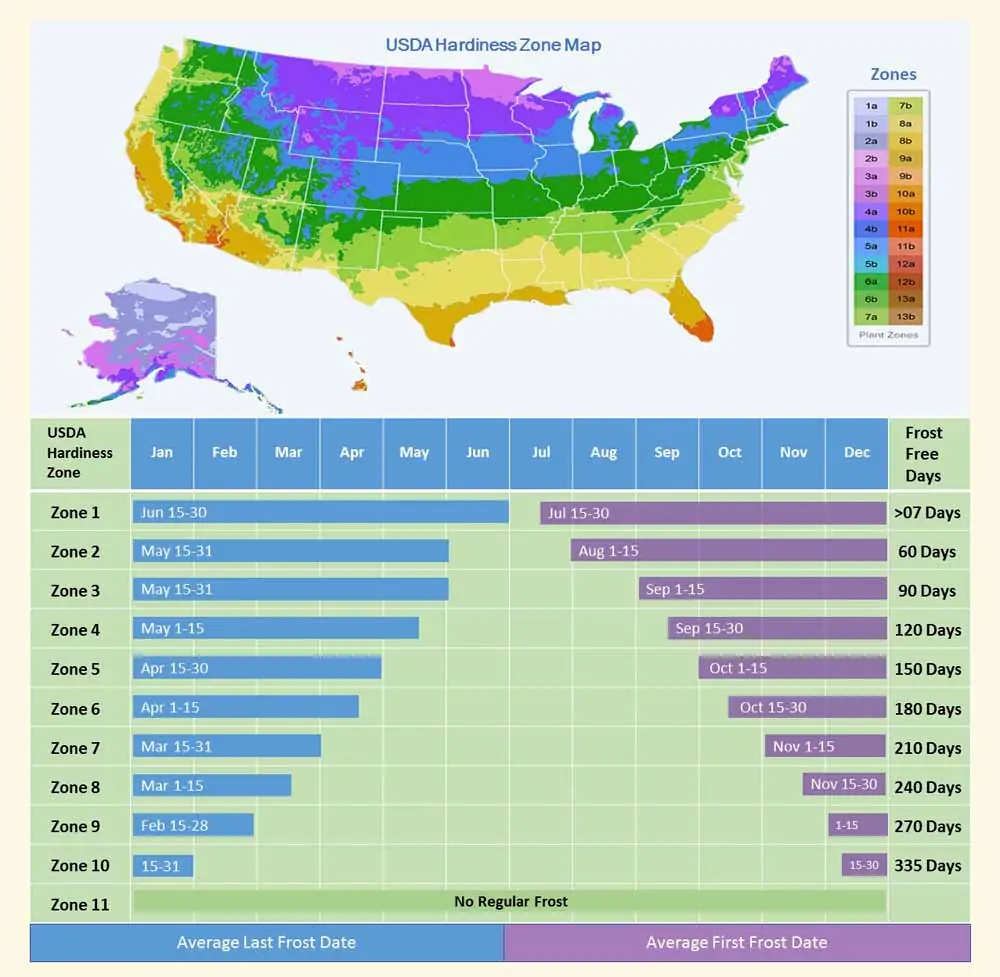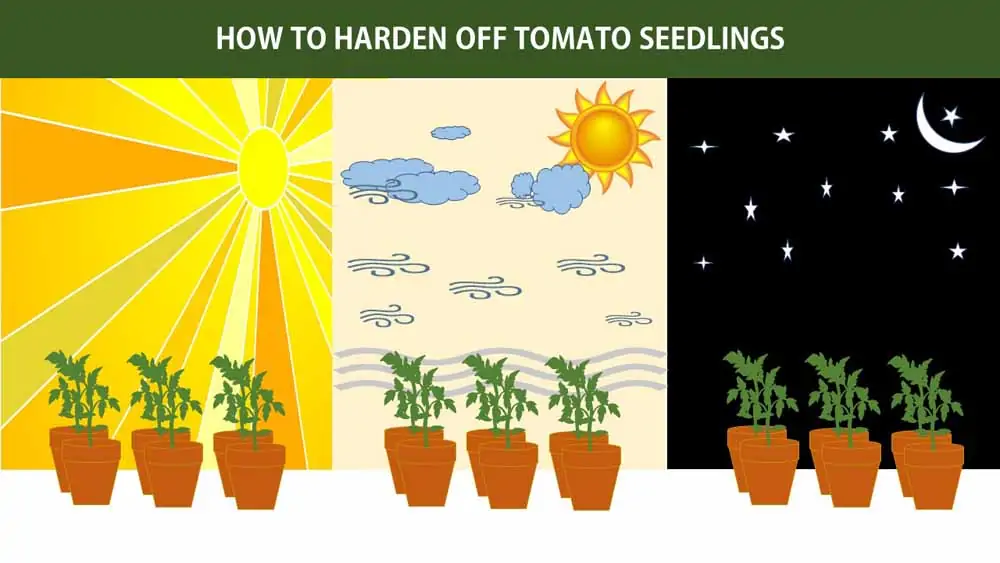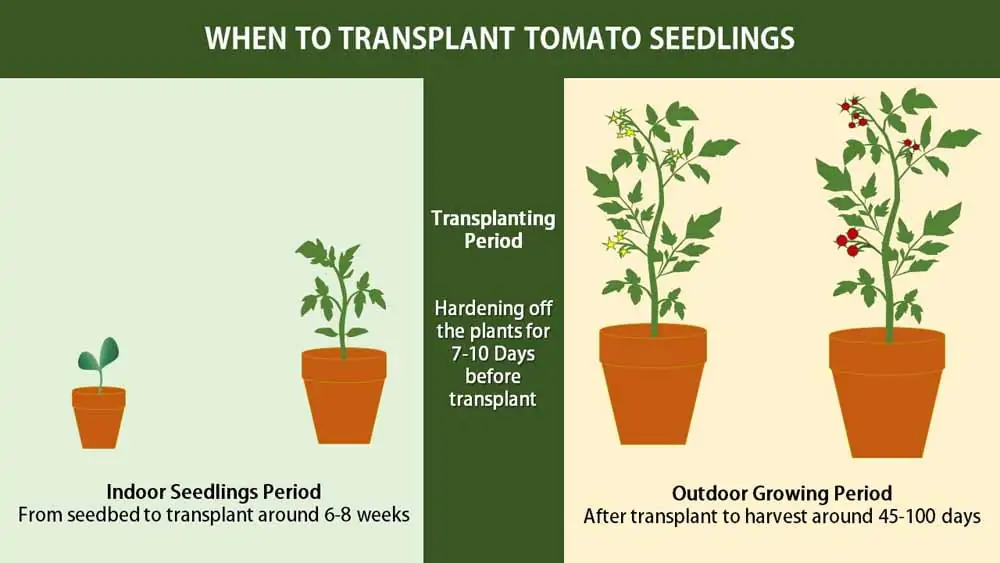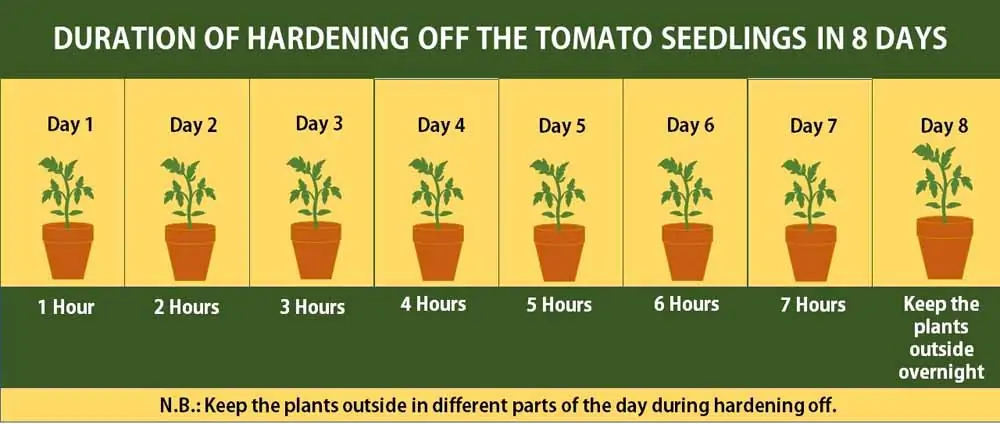Transplanting tomatoes is not rocket science. So, you can transplant your tomato plants from your indoor seedbeds to outdoor gardens or containers.
In this article, I will give you some tips and step by step instructions to move your tomato seedlings outside. Become a successful tomato gardener safe transplanting is very important.
Transplanting stress may harm plants growth, reduce production even kill your tomato plants. So, your safe and careful steps can save your tomato plants from the stress and bring you healthy harvest.
Step# 01: Understanding the basics of transplanting tomatoes
While moving tomato seedlings outside, you may face several tricky parts of transplanting issues. So before moving your tomato plants, you must have to get a clear idea of those issues.
Planting Zone:
Different planting zone has different weather condition and the transplanting method of the particular zone have some variations.
FOR EXAMPLE, Zone 7 weather condition, soil temperature, total frost free days and tomato varieties will not exactly match with zone 9.
As a result, when I speak in general for transplanting tomatoes it doesn’t cover all the planting zones equally. You have to calculate properly based on the nature of your particular planting zone.

Indoor seedlings age:
Typically, you have to sow your tomato seeds in the indoor seedbed around 6-8 weeks before the last frost date according to your specific planting zone.
Sometimes the duration may longer due to a late frost.
In that case, the seedlings need to keep indoor seedbed longer than average time.
Now the problem is how long you can keep tomato seedlings indoors before transplanting them outdoor garden or containers.
Actually, it may depend on some other related factors like-
- The duration between the scheduled last spring frost date and the exact last frost date.
- 10-14 days’ security time to confirm the last frost date.
- Days to confirm the constant night time temperature over 55° Fahrenheit or (13°) before transplanting tomatoes.
- Unexpected problems of the individuals
Calculate total days of delay plus 8 weeks aged seedlings and finally, you will find the ultimate days of delay.
In this situation, other side effects may appear due to the unexpected delay of transplanting tomato seedlings. Such as-
- Flowering before transplanting
- Holding fruits before transplanting
- Facing extreme transplanting stress
- Less production
- Weak plants
Soil temperature:
During transplanting tomato seedlings soil temperature plays a vital role. Ensure the nighttime soil temperature remains above 55-60° Fahrenheit for better result.
If the ground temperature down below 55° Fahrenheit at night, it will slow down the plants’ growth and reduce production.
Total frost-free days:
Different planting zone has a different number of frost-free days to harvest. So it’s very important to know how many frost-free days you will get after transplanting.
Tomato varieties:
How many frost-free days you will get after transplanting help you to determine which tomato varieties you should pick.
For shorter cultivating period pick determinate tomato varieties and longer cultivating period choose indeterminate tomato varieties.
Timing:
This is the most important factors in gardening.
Proper soil type, right varieties but bad timing of last frost date, nighttime soil temperature, and watering during transplanting tomato plants can ruin everything you did before.
Step# 02: How to harden off tomato seedlings?
Hardening off before transplanting helps your tomato plants steadily adjust in a tough weather condition.
In an indoor condition, seedling gets comfortable weather to grow up until their transplant to outdoor. The seedlings receive comfortable zone, food, water, required warm temperature in an indoor platform.
On the other hand, transplanted plants have to face sudden temperature fluctuation, hard rain, cold nights, direct sunlight, and strong wind exposure.
So, hardening off your tomato plants can reduce these risks of transplanting stresses. Here I give you some useful tips to harden off your tomato seedlings.

- Start hardening off your tomato seedling from the day after the last frost date.
- Harden off your seedlings at least 7-10 days after the last frost date.
- At the beginning start slowly and keep your tomato seedlings outside for 1-2 hours and bring them back indoors again. Don’t keep them outside at night for the first few days.
- Gradually increase an hour every day up to a week. Increase the time of sun exposure and decrease the level of watering during hardening off.

- Do not apply fertilizer during hardening off your tomato seedlings.
- Choose a shady spot to keep the seedlings outside and make sure the place is able to protect direct sunlight and strong wind flow to the seedlings.
- While moving your tomato plants outside you should also place them in a safe zone where slugs can’t reach your plants. Moreover, birds can also knock over your plants while looking for grubs.
- In the beginning, avoid the midday and afternoon time while the temperature goes extreme.
- Morning is best for moving your seedlings outside for the first few days. Gradually move them outside in different part of the day.
- Watch over your seedlings if they show any symptom of stress (like wilting) immediately bring them back inside.
- Water your seedling before moving them outside.
- Keep continue these steps at least 7 days and finally leave them outside overnight.
- Check the hourly weather forecast online on the next day at your local area. Predict the crop’s minimum temperature according to the relative hardiness of tomato plants. If the temperature drops below 55° F or 13° C don’t move them outside.
- Tomatoes are tender plants which perform well in warm weather condition. They cannot withstand frost or light frosts. So start hardening off your tomato seedling after the last frost date.
- While the seedlings don’t show any symptoms of stress after staying outside all day long, now is the time to transplant your tomatoes in the garden.
Moving the tomato plants outdoor and bring them back again inside every day is a little bit hassle and time-consuming for you.
But, trust me, these seven days afford can protect your tomato plants from the transplanting stress and help them performing better to produce a higher yield.
Step# 03: Soil preparation
Till the soil at least 6-8 inches depth before planting tomatoes. Keep in mind that, warmer soil (65-75° F) helps to grow faster the tomato plants.
So, after preparing the soil, covered it up with black plastic. It will hold the temperature from the sunlight exposure during day time to keep the soil warm at night. Start this job a couple of weeks before transplanting your seedlings in the garden to get a better result.
Add some soil nutrients to the tomato holes for getting tasty and flavorful tomatoes. To do that, test your garden soil to measure the soil pH level and the nutrients deficiency at first.
After getting the soil test report to amend your soil and provide some extra elements like baking soda, fish heads, eggshells, banana peels, Epsom salt, old compost manure, kelp fertilizer, bone meal, used coffee ground or other homemade fertilizers.
Read more about preparing the soil for tomatoes.
Step# 04: Watering:
Water your tomato plants deeply before 1-2 hours of planting. After digging the holes add necessary compost fertilizer in it and pour some water.
After transplanting, slowly provide a gallon of water for each plant to set them well in the ground.
Check your tomatoes for the first two weeks and water them regularly to keep the soil moist after transplanting.
From day 1-10 provide a quart of water for each tomato plants daily and day 11-14 provide a gallon of water depending on the weather condition.
After two weeks of special care of watering, provide 2 gallons of water for each plant per week.
The amount of water for tomato plants may vary on the weather condition and the soil structure.
Read more about watering tomatoes.
Step# 05: When and how-to transplanting tomato plants:
The right time and way of transplanting tomatoes may depend on some important factors. Sincerely follow the guidelines can bring you success. Such as:

Plants height, age, and soil temperature:
Your tomatoes are ready to transplant outdoors when they are at least 3-4 inches tall or have their second set of leaves and the nighttime temperatures constant above 55° F.
Some gardeners wait until the plants grow up to 6-10 inches tall or measure the height of the seedlings reaches three times of the diameter of its pot before transplanting.
So, it’s a little bit confusing to determine the right height to transplant tomato seedlings.
My suggestion is to follow the plants’ age between 6-8 weeks and let them grow as long as they can up to the last frost date. Then, transplant them when you have the right soil temperature after the last frost date.
However, the age and height of the seedlings may vary on the tomato varieties you choose for. So, carefully read the seed packet instructions or plant tags and follow the instructions properly to move your tomato plants.
Place selection:
Tomato plants need 6-8 hours of direct sunlight to grow and healthy harvest. So, choose a place where the sunlight is available and never choose a place which receives less than 5 hours of direct sunlight.
Arrange temporary shade for the plants to protect the direct sunlight for the first few days if possible.
Besides, don’t pick the same place which is used for growing tomatoes or other nightshade families’ (peppers, eggplants or potatoes) plants in the previous years affected by diseases.
In that case, choose a different disease-free place in your garden area to transplant your tomatoes.
How to dig holes for tomatoes:
Always dig deep holes for planting tomatoes. It helps to develop a strong root system for your plants. Moreover, any parts of the tomato stems can grow roots if it is covered with soil.
So, plant the whole seedlings under the soil, but keep the topmost leaves over the ground.
It has also some other benefits like as:
- It develops a strong root system to get the necessary nutrients from the soil.
- Helps leggy seedlings to develop strong roots along their stems.
- Withstand your plants in windy condition.
- Protect your plants from unnecessary fall down after transplanting.
Spacing between plants:
Spacing between tomato plants is so important when digging up holes for translating. It helps to grow the plants smoothly, also ensure enough air circulation.
Typically, 2-5 feet spacing is required for growing tomatoes depending on varieties.
For more specific, see the seed packet instructions for particular seed varieties you are planting.
Overcrowded tomato plants may invite some diseases. Besides, it can also hamper pollination and reduce fruit production.
Moving from seed pot to the ground:
Lever each seedling out of the seed pot with a table knife and loosen the roots carefully.
Don’t move the seedlings by lifting their stems. Once you break the stem during transplant, you never bring it back. So, move the seedling by lifting their leaves if needed.
Best time to transplant tomatoes:
The best time to plant your tomatoes outdoors in the late afternoon.
Choose a cloudy day to transplant your tomato seedlings to avoid the direct sunlight. You can easily transplant your seedling early in the morning if the day is cloudy.
## Side effects of late transplanting tomatoes:
You may fail to transplant your seedling on time due to late frost fall or the soil temperature consistency above 55° F. or other reasons. Whatever the cause is there has still some hope to catch the season. But you may face some problems due to late planting, such as:
Tomatoes flowering before transplanting:
Tomato plants won’t stop growing in indoor condition if you plant them late to the outdoor gardens. As a result, your tomatoes may start blooming indoors due to late spring frost before transplant.
In that situation, you can do two things to solve the problem.
Pinch off your first set of flowers of tomatoes:
Pinching off before transplanting tomatoes in the late spring helps to supply more energy to develop a stronger rooting system.
Additionally, the plants can absorb more nutrients and moisture from the soil to become stronger to stand against the windy conditions. Allow the tomato plants flowering after successful transplantation.
You can easily do this for your tomato plants if you have a longer growing period and your selected varieties produce fruits and become mature in-between of the timeline of first frost fall.
Transplant tomatoes with flowers:
If you have a shorter growing season then you should transplant your tomatoes with flowers to save the time.
In that case, you need to dig a deep hole and place the plants under the ground level with the lowest three sets of leaves. It will help to develop additional strong rooting system and sturdy to face the windy conditions.
Transplanting fruiting tomato plants:
Sometimes, uncertain weather conditions make delay of transplanting. Furthermore, you may get a limited time of a growing season for some particular zone. To cover this short growing season you have no choice left rather transplanting your fruit-bearing tomato plants.
Late planted tomato plants often become tall and weak than regular tomato plants. Moreover, it will be weaker if it is bearing fruits and often produce fewer fruits than timely planted tomatoes
Whatever to cover this situation you should pinch of your set of fruits on the plants before growing larger in your indoor containers. Besides you need to prune the 2-3 set of leaves from the lower part of the tomatoes before planting them outdoors.
At the same time, you must plant them a deep down around 60-70 percent of its stem under the ground when transplanting.
After transplanting the tomatoes just keep watering enough regularly rather providing additional fertilizer especially nitrogen. It helps the tomatoes growing taller and produces more foliage.
Your tomato plants will be well set in the ground after two weeks of time. Then, provide a fertilizer ratio (NPK) 5-10-10 depending on your soil test report.
## Is it possible to transplant large matured tomato plants with fruits?
I suggest you to avoid transplanting tomatoes if they are quite large.
But if you have no choice left then transplant the large tomato plants as it is without pruning leaves or pinching off fruits and flowers. Plant them deeper in the ground as much as you can with proper staking or caging.
Water the tomatoes regularly for 10-14 days after transplanting. Then provide them fertilizer to develop a strong root system.
In that case, provide fertilizer (NPK) 5-15-15 ration to recover late transplanting stress and develop a strong rooting system to produce healthy fruits.
It works most of the time but you will not get the harvest as you expect.
## How to transplant tomatoes in containers?
Transplanting tomatoes in containers a little bit different than a backyard garden. But the common thing you need do to harden off the tomato seedlings no matter wherever you wish to plant them. After that you should do the followings:
Choosing container:
Selecting the right container for tomatoes is very important. Tomato plants create a deep rooting system to get nutrients from the soil. So always pick a large well depth container for tomato plants.
Create some hole at the bottom of the container for the proper drainage system.
Typically, a five-gallon container is good for growing tomatoes but it mostly depends on the tomato varieties.
Potting soil:
The container soil mix should be lightweight, well-drained and high nutrients for growing tomatoes.
Tomato varieties:
Tomatoes get limited space to develop their roots to get nutrients from the container. So, choose the varieties carefully for your containers.
I suggest determinate varieties for the beginner tomato growers. Because they stop growing after a certain period of time and start producing fruits. Moreover, these varieties are suitable small spaces and containers.
Watering and Fertilizing:
Container soil cannot hold the water for a longer period of time so you need to maintain schedule watering every day after transplanting tomatoes. Besides, fertilize them on time to produce a higher yield.
Conclusion:
Transplanting tomato seedlings create a safe bridge between your indoor seedbed to the outdoor garden.
This method is very important because a simple mistake of transplanting process can ruin your previous 6-8 weeks of hard works and time. Moreover, after transplanting stress can reduce fruit production.
So, your couple of weeks of hard work during transplant tomatoes can save your previous 8 weeks of indoor works and confirm your upcoming healthy harvest.
Happy gardening.
Sources and Citations:
- https://modernfarmer.com/2015/05/how-to-grow-your-own-tomatoes-part-2-transplanting/
- https://homeguides.sfgate.com/big-can-tomato-plant-transplanting-58798.html
- https://garden.org/learn/articles/view/356/
- http://tomatoheadquarters.com/tomatoes-farm/tips-for-hardening-off-tomato-and-pepper-seedlings/
- https://gg.memberclicks.net/hardening-off-plant-starts

Leave a Reply